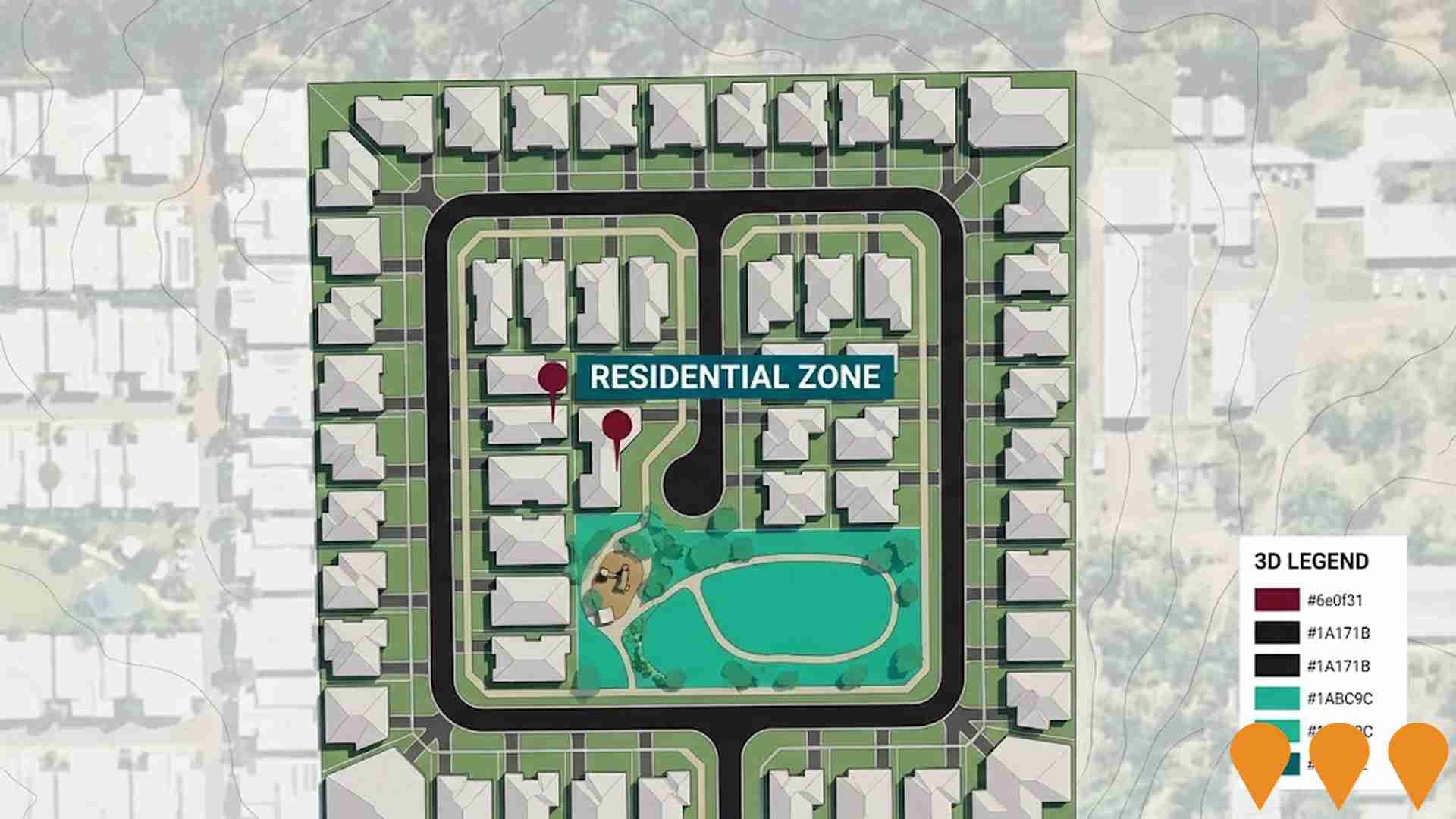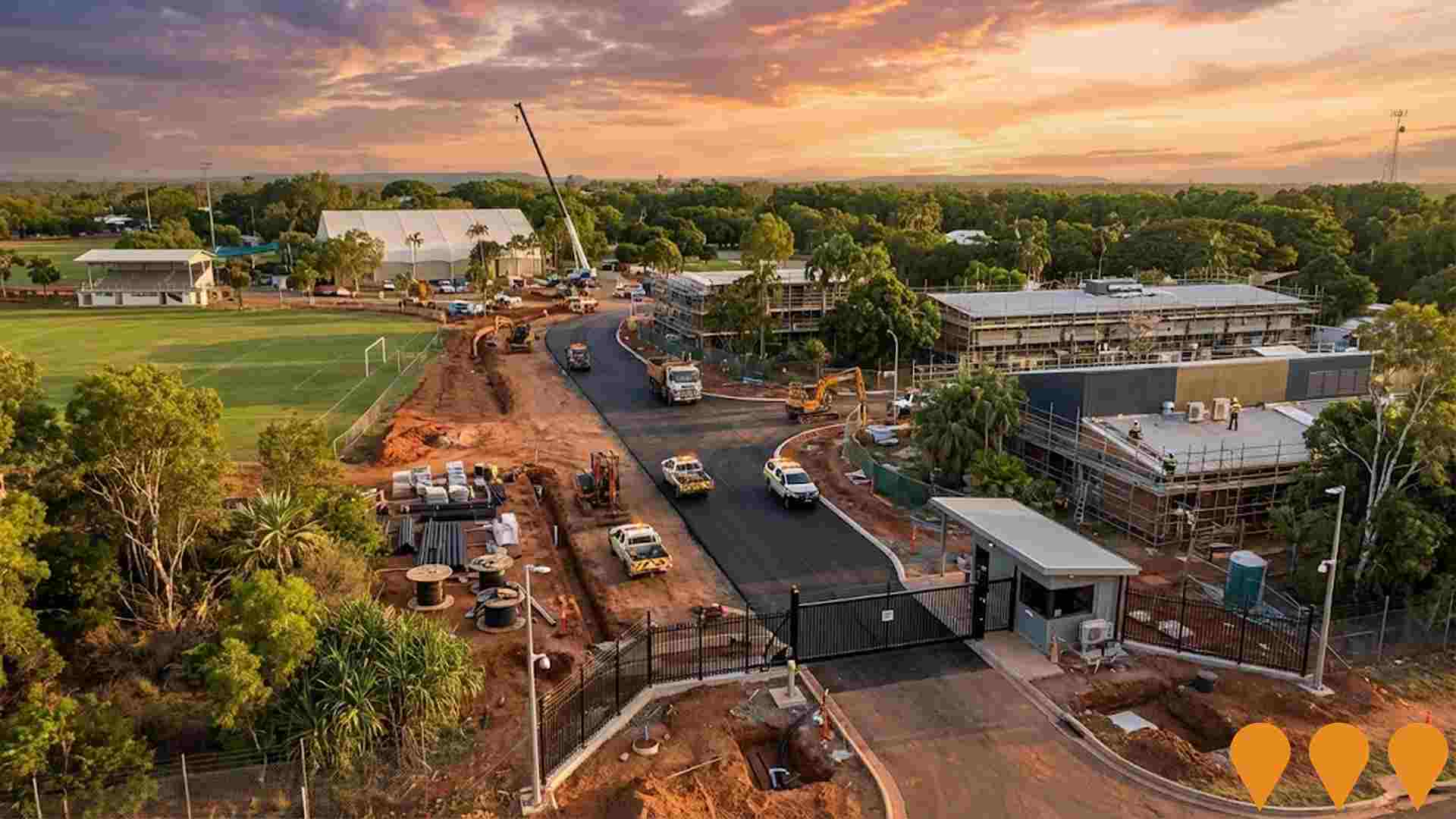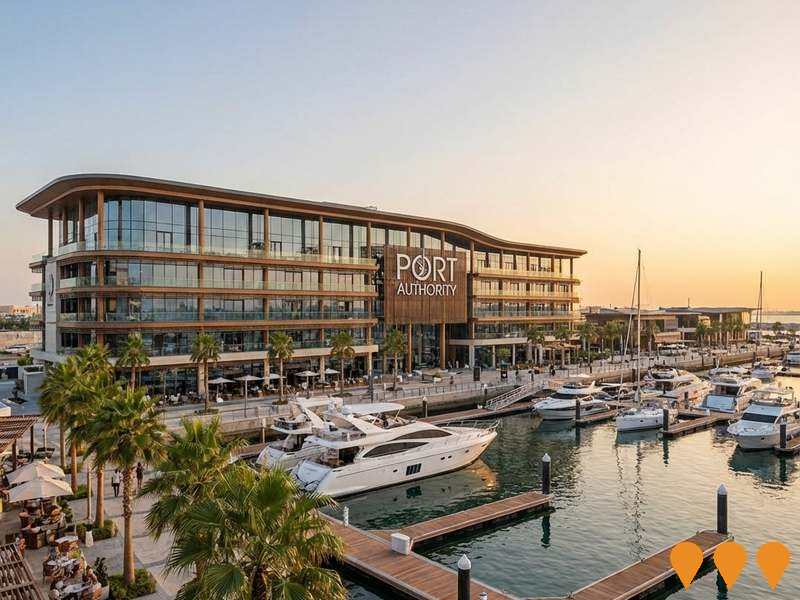Chart Color Schemes
est. as @ -- *
ABS ERP | -- people | --
2021 Census | -- people
Sales Activity
Curious about local property values? Filter the chart to assess the volume and appreciation (including resales) trends and regional comparisons, or scroll to the map below view this information at an individual property level.
Find a Recent Sale
Sales Detail
Population
Population growth drivers in Berrimah are strong compared to national averages based on AreaSearch's ranking of recent, and medium to long-term trends
Berrimah's population, as of Aug 2025, is around 2,594. This figure reflects an increase of 882 people since the 2021 Census, which reported a population of 1,712 people. The change is inferred from the estimated resident population of 2,374 in June 2024 and an additional 206 validated new addresses since the Census date. This results in a density ratio of 85 persons per square kilometer. Berrimah's growth rate of 51.5% since the 2021 census exceeded the SA3 area (7.6%) and the national average, marking it as a growth leader in the region. Population growth was primarily driven by interstate migration contributing approximately 74.0% of overall population gains during recent periods.
AreaSearch is adopting ABS/Geoscience Australia projections for each SA2 area, released in 2024 with a base year of 2022. For areas not covered by this data and to estimate growth post-2032, AreaSearch applies growth rates by age cohort to each area, as provided by the ABS in its latest Greater Capital Region projections (released in 2023, based on 2022 data). Future population dynamics predict exceptional growth, placing Berrimah in the top 10 percent of national statistical areas. By 2041, the area is expected to increase by 2,201 persons, reflecting an overall increase of 73.5% over the 17 years.
Frequently Asked Questions - Population
Development
AreaSearch assessment of residential development activity positions Berrimah among the top 25% of areas assessed nationwide
Berrimah averaged approximately 58 new dwelling approvals annually. Over the past five financial years, from FY21 to FY25294 homes were approved, with an additional 26 approved so far in FY26. Each year, for every dwelling built between FY21 and FY25, Berrimah gained an average of 2.3 new residents, indicating strong demand that supports property values.
The average expected construction cost value of new homes was $461,000. In FY26, $37.8 million in commercial development approvals have been recorded, reflecting high levels of local commercial activity. Compared to Greater Darwin, Berrimah records 1607.0% more development activity per person, offering ample choice for buyers. This is significantly higher than the national average, suggesting strong developer confidence in the area. Recent construction comprises 93.0% detached dwellings and 7.0% townhouses or apartments, maintaining Berrimah's low-density nature with a focus on detached housing that appeals to space-seeking buyers.
Notably, developers are constructing more detached housing than the existing pattern implies (60.0% at Census), reflecting persistent strong demand for family homes despite densification trends. With around 38 people per dwelling approval, Berrimah exhibits characteristics of a growth area. Population forecasts indicate Berrimah will gain 1,907 residents by 2041. Given current development patterns, new housing supply should readily meet demand, providing good conditions for buyers and potentially facilitating population growth beyond current projections.
Frequently Asked Questions - Development
Infrastructure
Berrimah has limited levels of nearby infrastructure activity, ranking in the 3rdth percentile nationally
Changes to local infrastructure significantly influence an area's performance. AreaSearch has identified nine projects likely impacting the region. Notable initiatives include Darwin Corporate Park, Tiger Brennan Drive and Berrimah Road intersection overpass, Defence Establishment Berrimah Redevelopment, Northcrest, with the following list detailing those most relevant.
Professional plan users can use the search below to filter and access additional projects.
INFRASTRUCTURE SEARCH
 Denotes AI-based impression for illustrative purposes only, not to be taken as definitive under any circumstances. Please follow links and conduct other investigations from the project's source for actual imagery. Developers and project owners wishing us to use original imagery please Contact Us and we will do so.
Denotes AI-based impression for illustrative purposes only, not to be taken as definitive under any circumstances. Please follow links and conduct other investigations from the project's source for actual imagery. Developers and project owners wishing us to use original imagery please Contact Us and we will do so.
Frequently Asked Questions - Infrastructure
Royal Darwin Hospital Mental Health Inpatient Unit and CSSD Upgrade
New three-storey mental health inpatient facility at Royal Darwin Hospital providing 18 acute inpatient beds plus a 6-bed Stabilisation Assessment and Referral Area (SARA), connected to the Emergency Department via an elevated enclosed walkway. Project also includes major upgrades to the Central Sterile Services Department (CSSD). Managing Contractor: Sitzler Pty Ltd. Works commenced in 2023 with practical completion expected mid-2025.

Australia-Asia PowerLink (AAPowerLink)
The world's largest renewable energy infrastructure project, comprising a 17-20GW solar farm and 36-42GWh battery storage in the Barkly Region, connected via HVDC transmission to Darwin and Singapore. The project received Commonwealth environmental approval in August 2024. It aims to supply up to 4GW of green electricity to Darwin industrial customers and export power to Singapore.

Darwin Light Rail Stage 1
A proposed mass transit system, likely light rail or rapid bus, connecting Darwin CBD to Palmerston via the Stuart Highway corridor. The project aims to manage future population growth, reduce congestion, and improve connectivity between the two major population centres as part of the long-term Darwin Regional Transport Plan. While currently in the strategic planning phase with no immediate construction funding, the corridor has been identified for future preservation to support a '30-minute city' concept.

Northcrest
A 21-stage, 15-year master-planned development aiming to deliver up to 2000 housing lots of various sizes. Includes parkland, childcare, commercial office buildings, petrol station, supermarket, senior living and residential apartments, and a community tavern restaurant.
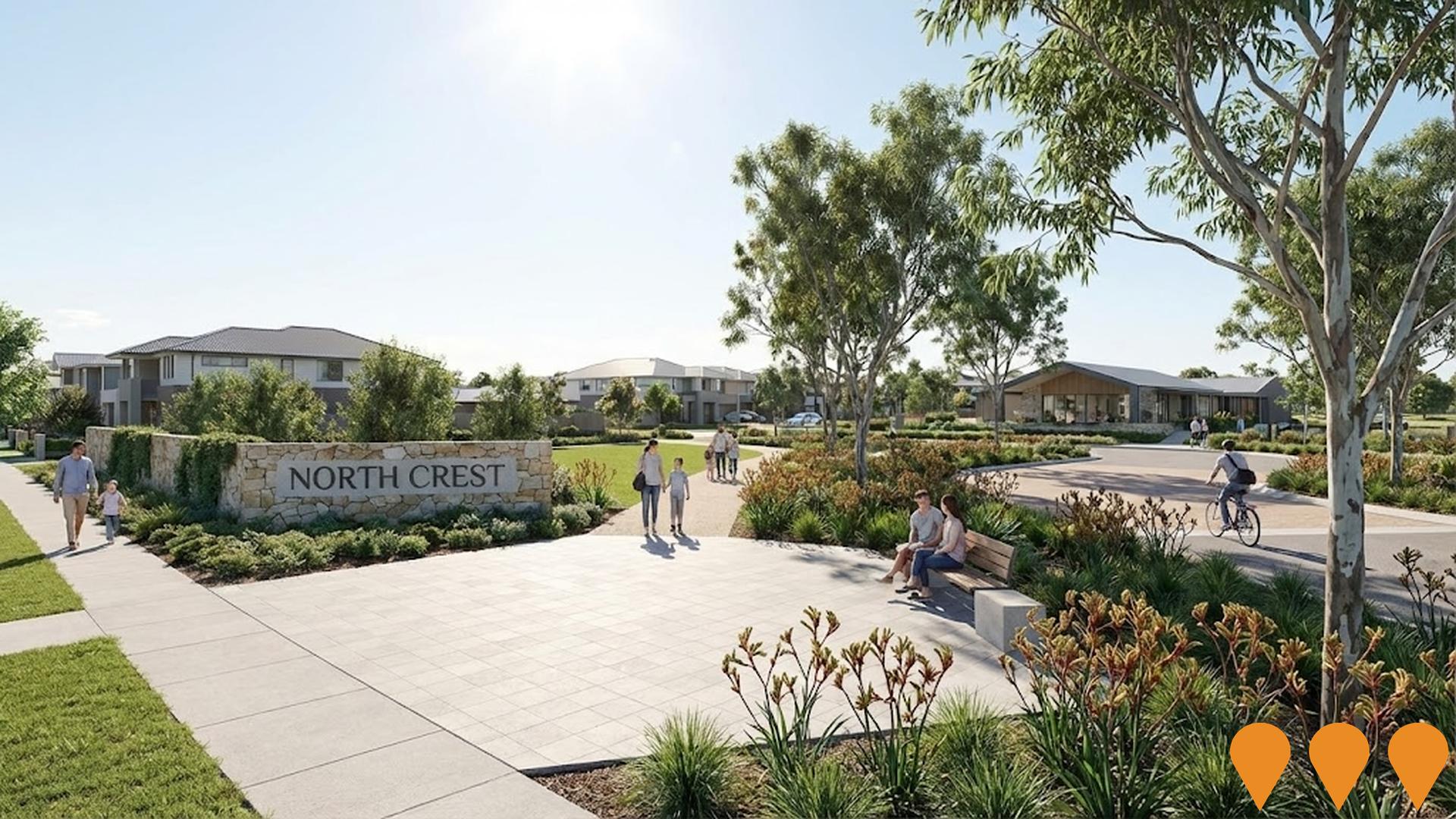
Desert Springs Octopus Renewable Energy Program
Majority Indigenous-owned developer pursuing a near-term pipeline of grid-connected solar and battery projects along the Darwin-Katherine Electricity System, with potential to expand into wind and green hydrogen. Partnership includes Octopus Australia with Larrakia Nation and Jawoyn Association to deliver utility-scale renewable energy and community benefit sharing.

Tiger Brennan Drive and Berrimah Road intersection overpass
Construction of a new overpass to improve road safety, reduce traffic delays, and increase freight connectivity. The new overpass carries Berrimah Road traffic over Tiger Brennan Drive. Final works include shared user paths, landscaping, and emergency services access.
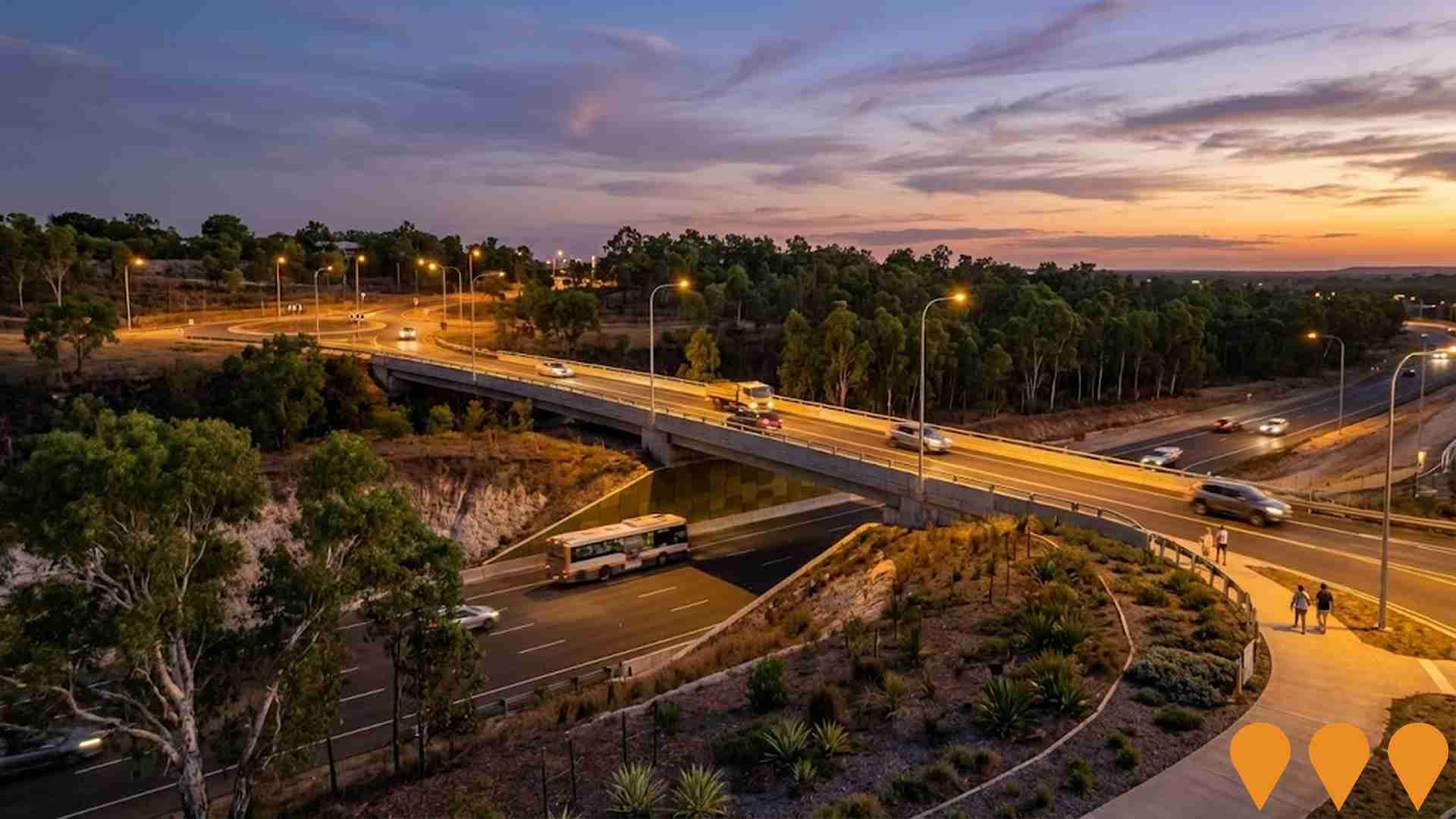
Hudson Creek Power Station
12MW natural gas-fired power plant, NT's first privately owned grid-connected gas generation facility. Features 25% lower emissions than average NT gas generators. Part of dual project with Batchelor Solar Farm, creating 162 construction jobs and providing vital grid stability to Darwin-Katherine network.

Ludmilla Wastewater Treatment Plant Upgrade
Upgrade of the existing wastewater treatment plant and associated pumping stations and rising mains, aimed at increasing robustness, optimizing treatment, improving environmental outcomes, and catering for future population growth until 2030. It was the largest sewer project ever undertaken by NT Power and Water Corporation.
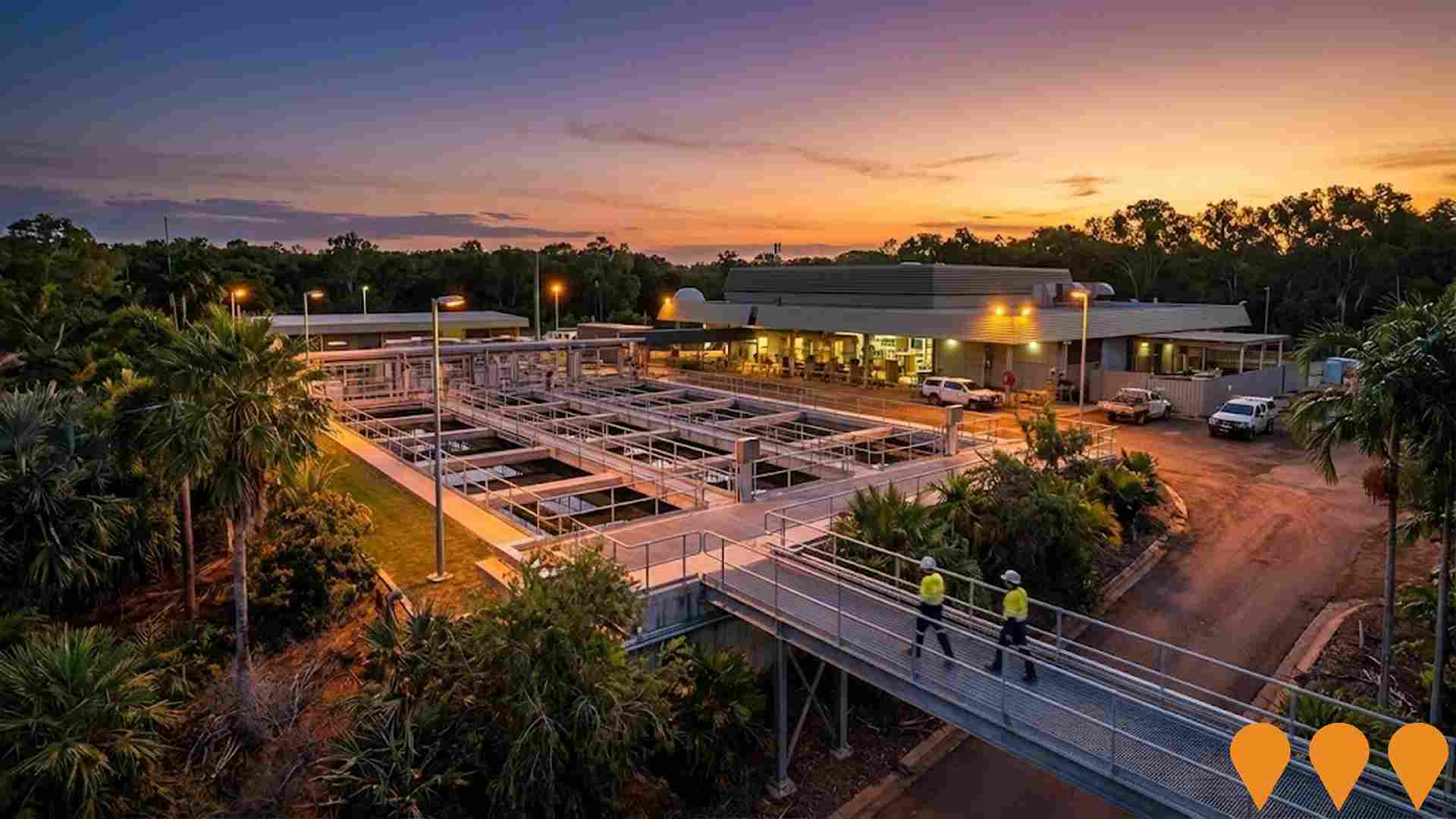
Employment
Employment drivers in Berrimah are experiencing difficulties, placing it among the bottom 20% of areas assessed across Australia
Berrimah's workforce is well-educated with significant representation in essential services sectors. The unemployment rate was 6.7% as of June 2015, with an estimated employment growth of 3.4% over the past year.
As of June 2025, 1,109 residents are employed, but the unemployment rate is higher at 3.7%, compared to Greater Darwin's 3.0%. Workforce participation in Berrimah lags behind Greater Darwin at 61.1% versus 69.7%. Major employment sectors include public administration & safety, health care & social assistance, and construction.
Education & training has limited presence with 5.2% employment compared to the regional average of 8.7%. The area functions as an employment hub with 3.6 workers per resident, attracting workers from surrounding areas. Between June 2014 and June 2015, employment increased by 3.4%, while labour force grew by 2.9%, reducing the unemployment rate by 0.5 percentage points. Jobs and Skills Australia's national employment forecasts from May 2015 suggest that over five years, national employment is expected to expand by 6.6% and by 13.7% over ten years. Applying these projections to Berrimah's employment mix indicates local growth of approximately 6.4% over five years and 13.3% over ten years.
Frequently Asked Questions - Employment
Income
Income metrics indicate excellent economic conditions, with the area achieving higher performance than 75% of national locations assessed by AreaSearch
AreaSearch's latest postcode level ATO data for financial year ending June 2022 shows median income in Berrimah was $66,506 and average income was $85,916. This compares to Greater Darwin's median income of $65,522 and average income of $75,260. Based on Wage Price Index growth of 12.01% from financial year ending June 2022 to September 2025, estimated current incomes would be approximately $74,493 (median) and $96,235 (average). Census data indicates Berrimah's household, family, and personal incomes rank between the 80th and 81st percentiles nationally. Income brackets show 37.4% of residents earn between $1,500 to $2,999 weekly (970 people), consistent with surrounding regions at 36.7%. Notably, 31.5% earn above $3,000 weekly. Housing costs consume 17.7% of income, but strong earnings place disposable income at the 77th percentile. The area's SEIFA income ranking places it in the 5th decile.
Frequently Asked Questions - Income
Housing
Berrimah displays a diverse mix of dwelling types, with ownership patterns similar to the broader region
Dwelling structure in Berrimah, as evaluated at the latest Census held on 28 August 2016, comprised 60.4% houses and 39.7% other dwellings (semi-detached, apartments, 'other' dwellings). This compared to Darwin metro's 68.4% houses and 31.6% other dwellings. Home ownership in Berrimah was at 18.9%, with the remainder of dwellings either mortgaged (42.8%) or rented (38.3%). The median monthly mortgage repayment in the area was $2,600, above Darwin metro's average of $2,028. Median weekly rent figure was recorded at $370, compared to Darwin metro's $350. Nationally, Berrimah's mortgage repayments were significantly higher than the Australian average of $1,863, while rents were less than the national figure of $375.
Frequently Asked Questions - Housing
Household Composition
Berrimah features high concentrations of family households and group households, with a higher-than-average median household size
Family households comprise 77.7% of all households, including 38.8% couples with children, 24.3% couples without children, and 11.3% single parent families. Non-family households account for the remaining 22.3%, with lone person households at 18.4% and group households comprising 4.0%. The median household size is 2.9 people, larger than the Greater Darwin average of 2.7.
Frequently Asked Questions - Households
Local Schools & Education
Berrimah shows strong educational performance, ranking in the upper quartile nationally when assessed across multiple qualification and achievement indicators
Educational qualifications in Berrimah trail regional benchmarks. As of 15+ residents, 30.5% hold university degrees compared to SA3 area's 36.1%. This gap suggests potential for educational development and skills enhancement. Bachelor degrees lead at 22.6%, followed by postgraduate qualifications (5.2%) and graduate diplomas (2.7%).
Trade and technical skills are prominent, with 33.4% of residents aged 15+ holding vocational credentials – advanced diplomas (10.1%) and certificates (23.3%). Educational participation is high, with 39.0% of residents currently enrolled in formal education. This includes 12.0% in secondary education, 10.8% in primary education, and 6.9% pursuing tertiary education. Berrimah's 4 schools have combined enrollment reaching 1,120 students as of the latest data. The area demonstrates above-average socio-educational conditions (ICSEA: 1070). The educational mix includes 1 primary school and 3 K-12 schools. As of current figures, the area functions as an education hub with 43.2 school places per 100 residents – significantly above the regional average of 16.9 – attracting students from surrounding communities. Note: where schools show 'n/a' for enrolments please refer to parent campus.
Frequently Asked Questions - Education
Schools Detail
Nearby Services & Amenities
Transport
Transport servicing is good compared to other areas nationally based on assessment of service frequency, route connectivity and accessibility
Berrimah has 21 active public transport stops. All are bus stops. There are 51 different routes serving these stops.
Together, they provide 2,728 weekly passenger trips. Residents' access to transport is limited; on average, they live 829 meters from the nearest stop. On a typical day, there are 389 trips across all routes, which amounts to around 129 weekly trips per individual stop.
Frequently Asked Questions - Transport
Transport Stops Detail
Health
Berrimah's residents boast exceedingly positive health performance metrics with common health conditions slightly more prevalent than average across both younger and older age cohorts
Health outcomes data shows Berrimah has slightly higher prevalence of common health conditions compared to averages across both younger and older age cohorts. Approximately 63% (1,642 people) have private health cover, higher than Greater Darwin's 56.7%, but close to the national average of 55.3%. Arthritis and mental health issues are the most common medical conditions, affecting 4.6% and 4.1% respectively.
Around 81.9% of residents report no medical ailments, compared to 77.0% in Greater Darwin. Berrimah has a lower proportion of residents aged 65 and over at 7.6% (196 people), compared to Greater Darwin's 12.3%.
Frequently Asked Questions - Health
Cultural Diversity
Berrimah is among the most culturally diverse areas in the country based on AreaSearch assessment of a range of language and cultural background related metrics
Berrimah has a high level of cultural diversity, with 35.9% of its population born overseas and 42.9% speaking a language other than English at home. Christianity is the predominant religion in Berrimah, accounting for 53.9% of people. Notably, the 'Other' religious category comprises 3.6% of Berrimah's population, compared to 1.7% across Greater Darwin.
In terms of ancestry, the top three groups are Australian (19.3%), English (16.6%), and Australian Aboriginal (14.9%), with the latter being significantly higher than the regional average of 7.4%. There are also notable differences in the representation of certain ethnic groups: Filipino is overrepresented at 11.6% compared to the regional average of 4.7%, Greek at 2.8% versus 3.7%, and Indian at 3.6% compared to 3.2%.
Frequently Asked Questions - Diversity
Age
Berrimah's young demographic places it in the bottom 15% of areas nationwide
Berrimah has a median age of 32, which is younger than the Greater Darwin figure of 34 and substantially under the Australian median of 38. Compared to Greater Darwin, Berrimah has a higher percentage of residents aged 15-24 (15.3%) but fewer residents aged 65-74 (4.5%). Between 2021 and present, the age group of 35-44 has grown from 15.0% to 16.0% of Berrimah's population, while the 65-74 cohort has declined from 5.8% to 4.5%. By 2041, demographic projections indicate significant shifts in Berrimah's age structure, with the 45-54 age group projected to grow exceptionally, increasing by 364 people (113%) from 322 to 687.
